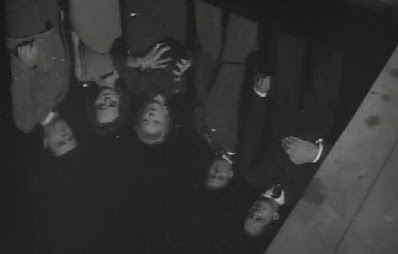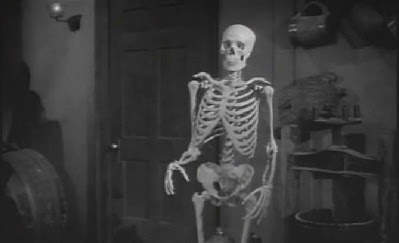Walter Grauman
Some superb opening credits - a couple making out in their car in broad daylight, a child being mean to a passed-out drunken bum, firecrackers exploding trash cans, busy drivers obnoxiously laying on their horns, a dead dog lying in the middle of the road that passers-by simply gawk at it - set the stage for this potent commentary on man's casual inhumanity to his fellow man, looser mores and the increase in everyday violence and cruelty in society. Yes folks, the world sure can be an ugly, ugly place. The radio is full of news stories about traffic accidents, international strife, war, nude decapitated murder victims and other not-so-wonderful things. People aren't quite as nice, friendly and trust-worthy as they used to be. And some take it one step further in their willingness to take advantage of you when you're at your most vulnerable. Vulnerable like Cornelia Hilyard (Olivia de Havilland). Cornelia's a successful, wealthy writer who lives in a large, well-kept home full of antiques, silver and other expensive valuables, but she's recently broken her hip and has to walk with a cane. Unable to use the stairs, she's even had to install an elevator to move between floors. A very slow... and, as it turns out, very unreliable elevator.
Either divorced, never-married or widowed, Cornelia shares her home with her unhappy, almost-30-year-old grown son Malcolm (William Swan) and there's a strange, co-dependent and somewhat unhealthy dynamic going on between the two of them. They refer to each other as "darling" and "love," she gets kisses in the morning, leans in and complements the smell of his aftershave and gets giddy that he's left behind a "love letter" for her. If one didn't already hear him call her "mom" then one would assume the two are actually a couple, not mother and child. Malcolm shoots resentful looks her way when she's not looking and seems like he can't get out of the house soon enough for a trip he's going on. Malcolm won't be back for several days, but seeing how the letter he's left behind (which Cornelia has yet to read) has lines like "I can't go on this way" and "I'll kill myself" on it, one can assume the relationship is no longer working for him. Malcolm leaves, Cornelia gets in her elevator to go back upstairs, it lifts off the ground a good eight or so feet and then the power goes out.
Trapped in the elevator on a sweltering summer day, Cornelia uses an emergency button which rings an alarm bell outside her home. Instead of getting a concerned passer-by's attention, the bells attracts mentally-disturbed, stuttering wino George L. Brady Jr. (Jeff Corey) who pops in long enough to raid her liquor closet, break stuff and scream "Repent! Repent! Repent!" George steals a few things, runs down to the pawn shop and then enlists the aid of sleazy hustler Sade (Ann Sothern) in clearing out the place. George also managed to attract the attention of violent, formerly-incarcerated, woman-beating hoodlum Randall O'Connolly (James Caan), his sidekick Essie (Rafael Campos) and his spacey, drugged out girl Elaine (Jennifer Billingsley). Once Randall's on the scene, he promptly knocks out George and forces Sade to help them carry stuff out of the house. Helpless and trapped, Cornelia has no other choice but to observe all of the frantic action as it plays out before discovering the intruders are planning on killing her. Can she escape her "cage" (and the house) before it's too late?
Despite the sometimes clumsy use of voice-over, this top notch shocker -
understandably quite controversial upon release (and even banned in the
UK) - has managed to retain its bite for 50 long years. The premise is
completely plausible, the character actions ring true, the violence is
upfront and sometimes startlingly brutal, the entire cast give highly
effective performances and the ending is truly surprising. Sothern is the stand-out amongst the supporting cast and de Havilland (in a role originally intended for Joan Crawford) gives a bravura,
go-for-broke performance that's among her best work in a long and
distinguished career. It's tense, suspenseful and unpredictable, tautly
directed and written and quite beautifully photographed by Leo Garmes.
The film didn't do much to bolster director Grauman's future big screen prospects, so he ended up primarily working on television projects the remainder of his career. He made his feature debut with the jungle shocker / Allison Hayes vehicle The Disembodied (1957), and from there went on to make the made-for-TV horror flicks Daughter of the Mind (1969), Crowhaven Farm (1970), Are You in the House Alone? (1978), Covenant (1985) and Nightmare on the 13th Floor (1990).
★★★1/2








































